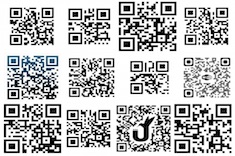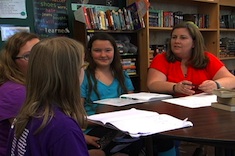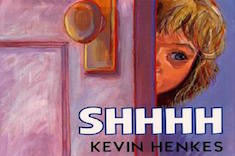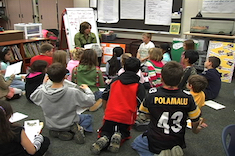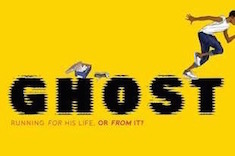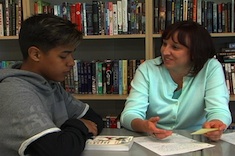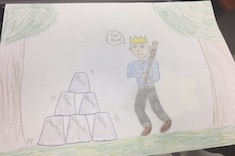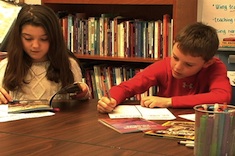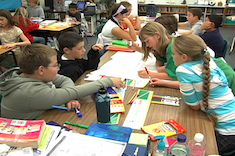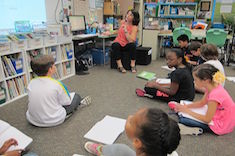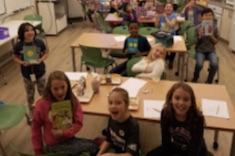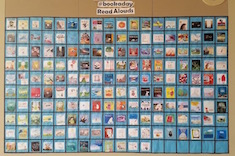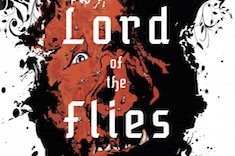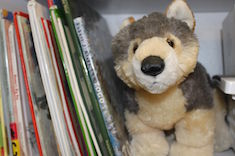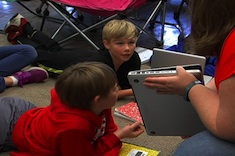Teaching Reading
Our contributors lead reading workshops in classrooms with creative flair. Over the past 12 years, we've filled our site with loads of suggestions, tools, and tips for using engaging books throughout the curriculum to hook kids on reading. Here is where you will find many stories of successful and not-so-successful workshop days, and what we learned from them. We bring these stories to life through hundreds of video examples.
Latest Content
QR Code Listening Stations
Listening stations are invaluable in elementary reading workshops, and can also be a hassle to set up and maintain. QR codes to the rescue! Stephanie Affinito shares how she helps teachers use simple online tools for setting up QR code listening stations.
Making Co-Teaching Work
Kate Mills and Tara Barnett often write together about their experiences as co-teachers. They share their best advice for teachers and school administrators on how to make co-teaching partnerships between classroom teachers and special educators work.
Writing a Strong Conclusion to a Literary Analysis Essay
Christy Rush-Levine helps eighth grader Katherine sort through tools and strategies for writing a strong conclusion to her literary analysis essay.
Girls’ Book Share in Fifth Grade
Katherine Sokolowski demonstrates how she helps a group of girls in her fifth-grade classroom learn to help each other select books based on previous experiences and tastes.
Children’s Books: Mirrors and Windows
Is your mentor text a mirror for students? Shari Frost explains the term and provides criteria for selecting mirror books.
Assessment Refresh
Christy Rush-Levine considers how her rubrics do not acknowledge different levels of support some students need to accomplish tasks. She rethinks her rubric design to include support, and in the process fosters more independence and reflection in students. Download the assessment rubric.
They Don’t Read at Home
Cathy Mere suggests strategies for working with struggling students who read very little at home.
Color-Symbol-Image: A Thinking Routine for Read Alouds
Andrea Smith uses the Color-Symbol-Image thinking routine during read alouds to promote deeper reflection among students.
Using Read Alouds to Build Fluency
Tara Barnett and Kate Mills find an ingenious way in the upper elementary grades to help their struggling readers develop fluency through read alouds.
More Nonfiction Read Alouds
Franki Sibberson shares strategies for incorporating more nonfiction into read-aloud times throughout the day.
Great Books for African American Boys
Shari Frost deals with the failure of a classic read-aloud text to reach young African American boys by finding more engaging books for them.
Eighth-Grade Conference: Empathetic Reading
Christy Rush-Levine confers with eighth grader Julian about his strengths as an empathetic reader.
Sketching Your Way to a Big Idea
Tara Barnett and Kate Mills work with eighth graders who struggle to articulate big themes in literature. A breakthrough comes when they have the option of sketching their thoughts.
Exploring Text Features
Melanie Meehan works with a small group to talk through how nonfiction text features might enhance their informational writing.
Better Student-Led Literature Discussions
Gigi McAllister tries student-led discussion groups in her fourth-grade classroom, with disastrous results. She regroups the following year with multiple lessons, anchor charts, and preparation to ensure success.
Gradual Release of Responsibility in Small Groups
Tara Barnett and Kate Mills develop a process of pre-assessment, careful planning, and systematic recordkeeping to up the value of their small groups.
First-Grade Minilesson: Tricky Words
Bitsy Parks presents a minilesson on figuring out tricky words by recounting a student's strategy from a recent reading conference, using it to begin an anchor chart.
Balancing Reading and Talk
Mark Levine finds that the best way to deal with controversial topics like slavery in his middle school classroom is with open and focused whole-class discussions.
Building a Reflective Community
Andrea Smith builds reflection into whole-class discussions in her fourth-grade classroom by beginning an anchor chart with four different illustrations from the covers of a read-aloud.
Sentence Phrase Word: Student Independence for Word Learning
Andrea Smith uses the sentence-phrase-word thinking routine with her fourth graders to show how potent one word can be in understanding complex themes.
Lunchtime Author Discussion Groups
Gigl McAllister explains why she hosts optional lunchtime author studies, with practical tips on getting started.
Fourth-Grade Lunch Fan Club
Gigi facilitates one of her lunchtime author fan clubs, where everyone gets organized and brainstorms what they might explore in the group during this first meeting.
Sharing and Celebrating Summer Reading
Tara Barnett and Kate Mills share how they use the first days and weeks of school to celebrate summer reading and build a classroom community.
#bookaday in Middle School: Nuts and Bolts
Jillian Heise shares advice for teachers who want to try a #bookaday challenge of sharing at least one picture book each day with older students. She gives criteria for book selection, as well as examples of books to read at the start of the school year.
When a Book Doesn’t Work
Gretchen Schroeder is frustrated when a novel that has worked well for many years doesn’t appeal to her current high school students. Letting go of it is hard.
Stuck at Level E
Shari Frost assists a teacher who is instructing a child stuck at level E, and in the process reveals some of the issues in treating all levels equally.
Leveled Text Dilemma
"We don't have enough leveled texts!" is the cry from teachers. Heather Fisher helps them move beyond the school book room to more creative online resources to meet students' needs, and move beyond narrow definitions of text suitability.
The Scarlet Level
Stephanie Affinito tells everyone at a staff meeting to write their weights and ages on sticky notes so that she can post the numbers for the group to view. When teachers balk at the request, she has the perfect opening to discuss why focusing on levels in classrooms is a bad idea.
Conferring in First Grade: Reading Illustrations
Katrina Edwards helps a first grader use pictures to help her make sense of confusing text.
Environment Small Group: Habitat
Katherine Sokolowski leads a small group of fifth graders who have chosen similar topics for their projects in an environmental unit.
Browse Content By
Type
Category
- Assessment Tools
- Big Fresh Archives
- Booklists
- Choice Numeracy
- Classroom Design
- Common Core
- Community Building
- Conferring
- Content Literacy
- Digital Literacy
- English Language Learners
- Equity
- Family Relations
- Free Samples
- Guiding Groups
- Leadership
- Literacy Coaches
- Mentor Texts
- Minilessons
- New Teacher Mentors
- Podcasts
- Poetry
- Quote Collections
- Reading Strategies
- Self Care
- Struggling and Striving Learners
- Talking and Listening
- Teacher Study Groups
- Teaching Reading
- Teaching Writing
- Word Study and Vocabulary
Author
- Melissa Quimby
- Nawal Qarooni
- Gwen Blumberg
- Julie Cox
- The Lead Learners
- Hannah Tills
- Josie Stewart
- Ruth Metcalfe
- Mallory Messenger
- Becca Burk
- Jodie Bailey
- Vivian Chen
- Mary Brower
- Tiffany Abbott Fuller
- Stephanie Affinito
- Ruth Ayres
- Leigh Anne Eck
- Heather Fisher
- Shari Frost
- Julie Johnson
- Suzy Kaback
- Gigi McAllister
- Shirl McPhillips
- Melanie Meehan
- Cathy Mere
- Debbie Miller
- Tara Barnett and Kate Mills
- Tammy Mulligan
- Dana Murphy
- Bitsy Parks
- David Pittman
- Brenda Power
- Heather Rader
- Matt Renwick
- Mandy Robek
- Christy Rush-Levine
- Gretchen Schroeder
- Jen Schwanke
- Brian Sepe
- Katherine Sokolowski
- Stella Villalba
- Jennifer Vincent
Grade Level
Choice Literacy Membership
Articles
Get full access to all Choice Literacy article content
Videos
Get full access to all Choice Literacy video content
Courses
Access Choice Literacy course curriculum and training

